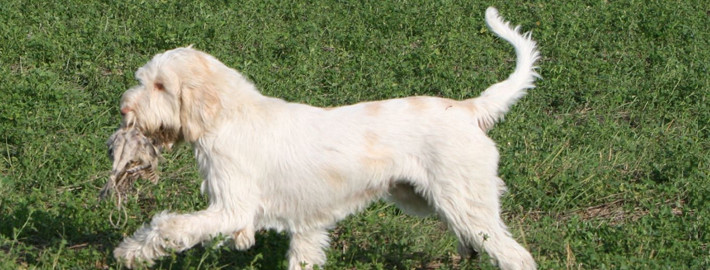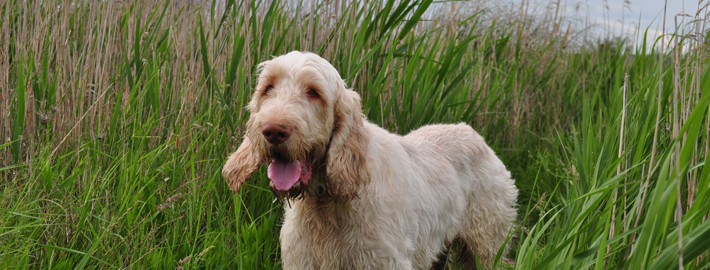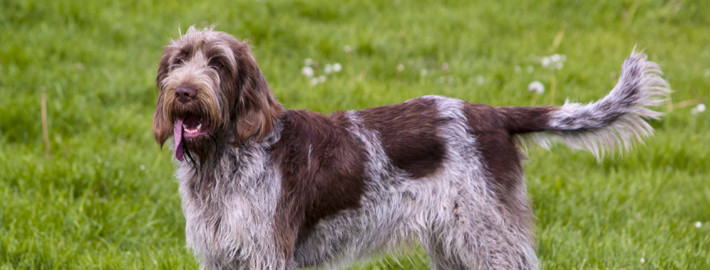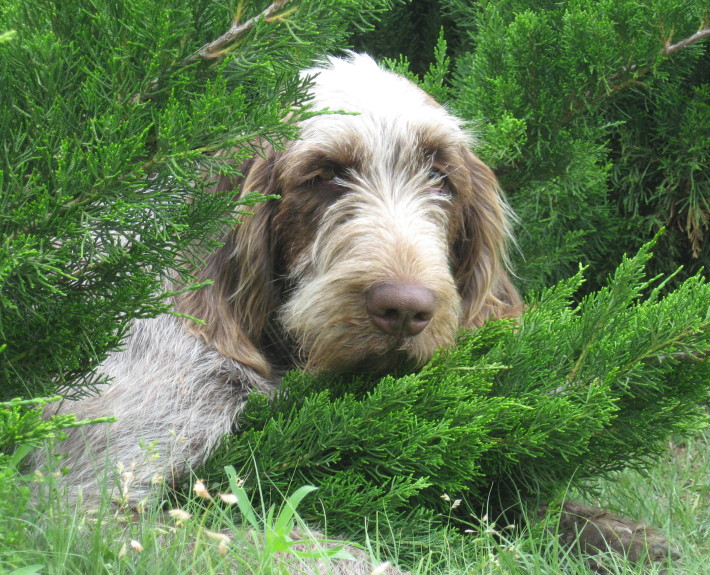What makes the Spinone Italiano Unique?
The spinone Italiano has a hound look about it, with a fairly long head and muzzle, large, dropped ears and somewhat pendulous lips. It is a strong, muscular dog, able to trot at fast pace all day and then retrieve over water or land. Its dense wiry coat allows it to hunt under any conditions. The coat is generally single, consisting of rough, dry, thick hair about 1.5 to 2.5 inches in length. Longer hair garnishing the lips and eyebrows adds further protection in addition to adding to its intelligent and gentle expression. This is a devoted and gentle dog, very willing to please. It is affectionate and gets along well with other dogs and pets and children. It is also courageous. The spinone is calmer and easier going than most pointing breeds.
Breed Groups
Page Contents
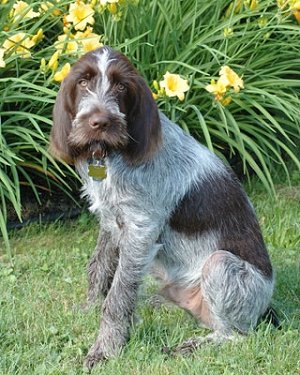
Is the Spinone Italiano Right For You?
An active, energetic breed, the Spinone loves to romp in the field, but is happy as long as it’s with its family. As a naturally cautious dog, owners should socialize the breed and begin training early. The Spinone is the ultimate wash and wear breed and should remain in a natural state, with just occasional brushing and hand-stripping. Owners beware, however – after a drink, their wet and messy beard may leave trail of water wherever they go! If you are considering purchasing a Spinone Italiano puppy, learn more. *Sporting Group; AKC recognized in 2000.
*Ranging in size from 22 to 27 inches tall at the shoulder.
*Hunting dog.
In 5 Words
- Gentle
- Docile
- Loyal
- Patient
- Friendly
Characteristics
Learn About the Spinone Italiano
Description
The Spinone Italiano is a large, muscular, squarely built hunting dog with large, floppy ears and a distinctive wiry coat. The long head has an almost unnoticeable stop, a roman-nosed muzzle and pendant ears. The bushy eyebrows, mustache and beard give the Spinone a gruff, almost grumpy appearance, but they protect the face from brush in the hunting field. The soft eyes and sweet demeanor of the Spinone offset his grizzled facial hair. The coat is 1.5 to 2.5 inches long and short on the head, ears, muzzle, legs and feet. The hair on the back of the legs is longer but does not fringe of feather. They may be white, white or brown with orange or brown patches, orange or brown roan. The tail of the Spinone is customarily docked 5 to 8 inches from the base and should be carried just below the back.
Size and Weight
Male Spinones should stand from 23 to 27 inches at the shoulder and females should stand 22 to 25 inches. The weight should be proportionate to the height of the dog, but males typically range in weight from 70 to 81 pounds and females from 62 to 70 pounds.
Coat and Color
The Spinone wears a single coat of wiry hair 1.5 to 2.5 inches long, that lies close to the body. The head, ears, legs and feet sport shorter hair. The mustache and beard are made up of a softer textured hair, but the eyebrows are stiff.
Spinones may be white, white with orange, orange roan, white with brown markings or brown roan. Chestnut brown is the most desirable color. Black, tan and tricolor dogs can not be shown, however they can make perfectly wonderful companion or hunting dogs.
Short History of the Spinone
The Spinone Italiano, or Italian Pointer, is one of the oldest pointing breeds. Although the exact origin of the breed is unknown, 15th- and 16th-century artwork has been discovered with images resembling the modern-day Spinone. There are those who believe the breed evolved from Celtic wirehaired dogs, while others think the Spinone dogs was probably brought to Italy by Greek traders during the Roman Empire.
What is known is that the development of the modern day Spinone Italiano primarily took place in the Piedmonte district of northwest Italy. In fact, its name is derived from an Italian thorn bush known as pine, indicative of the breed’s ability to make its way through thorny bushes.
The Spinone dogs were of great help during World War II, chasing and capturing many German patrols. By the end of the war, however, they faced extinction. Fortunately, proper action was taken in the 1950s to save the breed.
Although not a popular breed in the United States, it has gained recognition in Italy and other European countries.
Temperament
The Spinone has great strength and stamina, suited for hunting in all climates and on all terrains. Extremely intelligent, happy, upbeat and enthusiastic, the Spinone Italiano is a pleasant, easy-going breed. He is easily satisfied when treated as a lower-ranking member of his human pack family. Although serious when at work in the field, he definitely has a clownish side that is often quite entertaining. Never bossy or whiny, unless he does not see humans as pack leader, this gentle soul loves children, those he knows, and those he does not. Children must be taught how to display leadership skills. His great patience should never be taken for granted, for abuse is abuse, whether intentional or not. This breed gets along well with other animals, particularly enjoying the company of another dog. He wants to be with his people, whether that means at home or traveling. He is a quiet breed in general, but may occasionally howl along with a siren. The Spinone is not a protection breed. He is either unlikely to attack under any circumstance or would only do so if he or his family is directly threatened. He learns fast. If the dog does not see humans as ranking under him in the pack order, he can become stubborn. An intelligent hunter, the Spinone is aware of the difference between a real hunt and an exercise. For example, one breeder mentioned that his dog is perfectly willing to pick up downed birds, but he is reluctant to retrieve a training dummy. Nor does the breed perform in flashy style; instead being a slow, steady worker on the hunt or in the ring. Sadly, many judges penalize this, expecting all dogs to work like a pointer (field) or a Border Collie (ring). The Spinone can be timid if not properly socialized. It responds well to motivational training. The coat protects it from the water and freezing temperatures of the swamp, casually going into cold, deep water. It is an excellent swimmer and a model retriever.
Caring for Your Spinone Italiano
General Health
Generally a healthy breed for a purebred, the Spinone Italiano does have some special medical conditions to be aware of:
Hip dysplasia-Because this breed is a larger breed, hip dysplasia is a concern. This condition occurs when the bones in the hip become damaged in some way, creating pain and problems with movement. Some owners choose to have these painful hips replaced via canine orthopedic surgery.
Cerebellar ataxia-Also known as CA, this hereditary condition is a deadly disorder that affects Spinone Italiano puppies. In order for the puppy to have this condition, the gene must be passed on from both the mother and the father, as it is a recessive gene. Most puppies with this disorder will not live more than a year and many are euthanized at 10 to 11 months of age.
Grooming & Bathing
This breed requires just a small amount of stripping—pulling dead hair—as opposed to cutting, to neaten the coat. Other than that, just a weekly brushing will suffice. Bathe as necessary. Some say this breed grooms himself like a cat.
Exercise & Training
An active breed, the Spinone Italiano is a dog that wants to roam around as often as it can. As a hunting dog, this is a dog breed that is perfectly suited to retrieving, pointing, and hunting, if trained to do so. But this dog is also able to provide the perfect companionship to those who need assistance with everyday tasks. This highly intelligent dog is able to pick up new things and tasks quite easily, though it’s also the Spinone Italiano’s intelligence that can hinder their training just as easily. If the Spinone Italiano doesn’t feel that the task is necessary or useful, they may resist completing the task.

